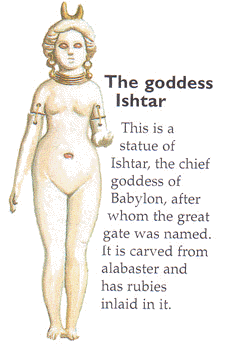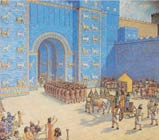
Ishtar
The Babylonian High-Mother-Goddess. Goddess
of Love, Fertility, Nature, Sex and War. Queen of Heaven
The most important Goddess of the Near-East and Western Asia.
Her symbols were the Star and Lion.
The Ancient city of Babylon stood on the banks of the river Euphrates. In Mesopotamia, today's Middle East.
Ishtar is a pretty fascinating all round Goddess.
Women prostituted themselves at her temple for her.
She turned a lover into a frog and sent another person on a quest for
immortality.
The gate is a symbol of her journey to the underworld where she went
through a ritual, and was killed by her sister, who was queen of the underworld.
Ishtar's Husband Tammuz had to take her place for her to leave the
under world. That was one version we read about, another was she
went to the underground to look for her husband Tammuz she smashed
the gates down to be let in, to find him, she had to go through the
ritual of being slowly stripped naked until she was aloud to have
him return.
was killed by her sister, who was queen of the underworld.
Ishtar's Husband Tammuz had to take her place for her to leave the
under world. That was one version we read about, another was she
went to the underground to look for her husband Tammuz she smashed
the gates down to be let in, to find him, she had to go through the
ritual of being slowly stripped naked until she was aloud to have
him return.
Rituals were sexual and sacred, for spring fertility and winter the
return of her son the return of light and longer days, such as Yule.
Full moon time was considered her bleeding time, so every one
rested.
Ishtar was life itself, which leads
to death and to a new birth. And who denies sex denies life,
who denies death denies life, and such a one will find neither life
joyful, nor death easy.
- From the Book of Goddesses & Heroines by Patricia Monaghan
This is a list of sites about and dedicated to the Goddess Ishtar:
This page last updated: 03/01/2018
